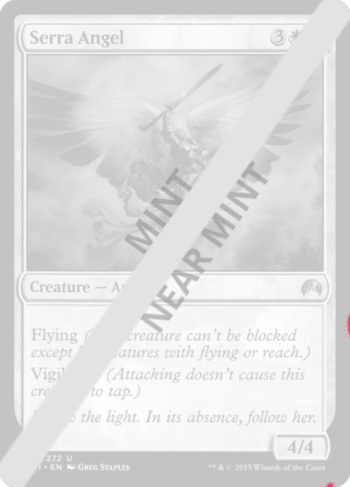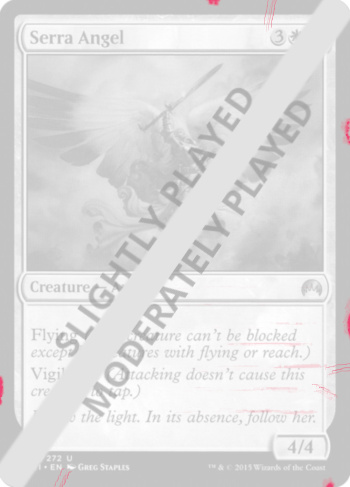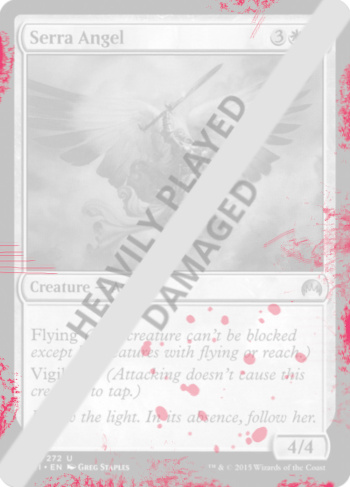MTG Condition Guide
When buying, selling, or trading cards, nothing is more important than condition. Any defect or damage - from scratches, surface-warping, off-centering, and so on - will decrease the value of a card. With this guide, MTG Stand users can identify their collections honestly and knowledgeably, making every transaction a fair and profitable one.MINT / NEAR MINT
| Generally speaking, Near Mint cards are free of any noticeable damage to either surface. Near Mint cards may appear with one or two minor scratches, blemishes, or nicks/impressions when under close inspection, but should otherwise be indistinguishable from like-cards. The edges and corners of Near Mint cards must be pristine and without tearing, crimping, folds, or an exposed inner layer.
Most modern-era singles (printed within the last fifteen-to-twenty years) start at Near Mint. The “Mint” condition is usually saved for cards judged upon their collectability, rather than playability – think Alpha, Beta, Unlimited, Revised, Arabian Nights, and Antiquity sets, particularly those that fall under the “Reserved List” (The “Reserved List” refers to specific cards that Wizards of the Coast as guaranteed to never reprint in a paper, tournament-legal form. The “Reserved List” covers the sets from Magic’s inception (Alpha, 1993), up until Urza’s Destiny (1999). See: https://mtg.gamepedia.com/Reserved_List). When purchasing high-profile singles, it’s better to know the “grade”, rather than just the assumed condition - after all, a single point difference can alter value by hundreds, thousands, or tens-of-thousands of dollars. Rest assured - the two reputable grading services, Beckett and PSA, always verify whether a card is genuine. Although most “pack-fresh and sleeved” cards will be Near Mint, there are exceptions: factory defects such as off-colored images or text-boxes, over- or under-inking of text, package-sealing mishaps, off-centered borders, or a missing holofoil stamp (for Rares and Mythic Rares produced in Magic 2015 and onward) can all lessen a card’s condition to Slightly Played or worse. Here, condition depends on the type of defect and its prevalence. When selling cards with factory issues (a.k.a. “misprints”), inform prospective buyers by creating a note – even if the error is obvious from your listing’s picture. Some misprints are highly-valued, so make sure you do your research. |
 |
SLIGHTLY PLAYED / MODERATELY PLAYED
| The differences between Near Mint, Slightly Played, and Moderately Played all fall along a gradient - Slightly Played cards often demonstrate a bit of use and wear on their front, back, or side surfaces, with minor but apparent scratches, blemishes, or nicks/impressions. Alternatively, a card is considered Slightly Played if it has a single moderate defect (a 3-5mm liquid stain or mark, e.g.) Most Near Mint cards that are regularly played with (particularly if only single-sleeved) or are improperly stored will quickly degrade to Slightly Played - eventually becoming Moderately Played. Moderately Played cards are more worn and/or damaged than Slightly Played, including moderate scratches, blemishes, or nicks/impressions. There may be some wear to corners or edges, including minor exposure of the white/blue inner paper. Or, there may be a single major defect (a mark or stain that covers 25 percent or more of the front surface, e.g.). Some Moderately Played cards may have slight buckling that self-corrects when placed in a deck sleeve (Dragon Shield; UltraPro, e.g.). If the damages or defects are recognizable from half a meter away, it’s likely Moderately Played or Heavily Played. |
 |
HEAVILY PLAYED / DAMAGED
| Heavily Played and Damaged cards have one or more of the following concerns: major scratches, blemishes, or nicks/impressions; moderate-to-major exposure of the inner paper; permanent folding/creasing of the corners or edges; extreme buckling; alterations without artistic merit (i.e. writings/drawings); or any other defect that modifies the integrity (but not structure) of the card. Heavily Played cards must still be tournament-legal: if the card can be identified by touch through a deck sleeve, it’s considered Damaged.
Damaged cards require significant restoration to be useable beyond kitchen-table play. The cost to restore most Damaged cards often outweighs their potential value, with some even beyond repair. Outside of high-profile purchases (i.e. “Reserved List” singles), most buyers should seek out Heavily Played or better. |
 |









